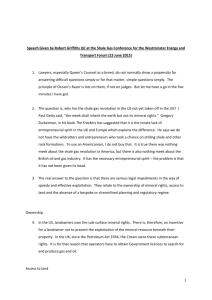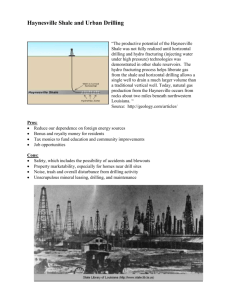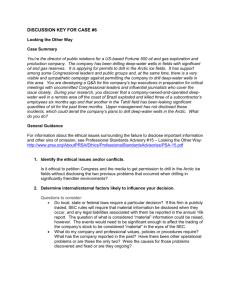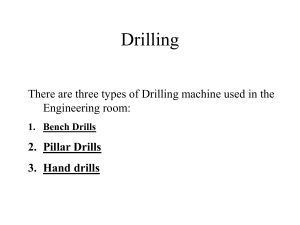movement analysis RULA + Rhoemert + Moore
advertisement
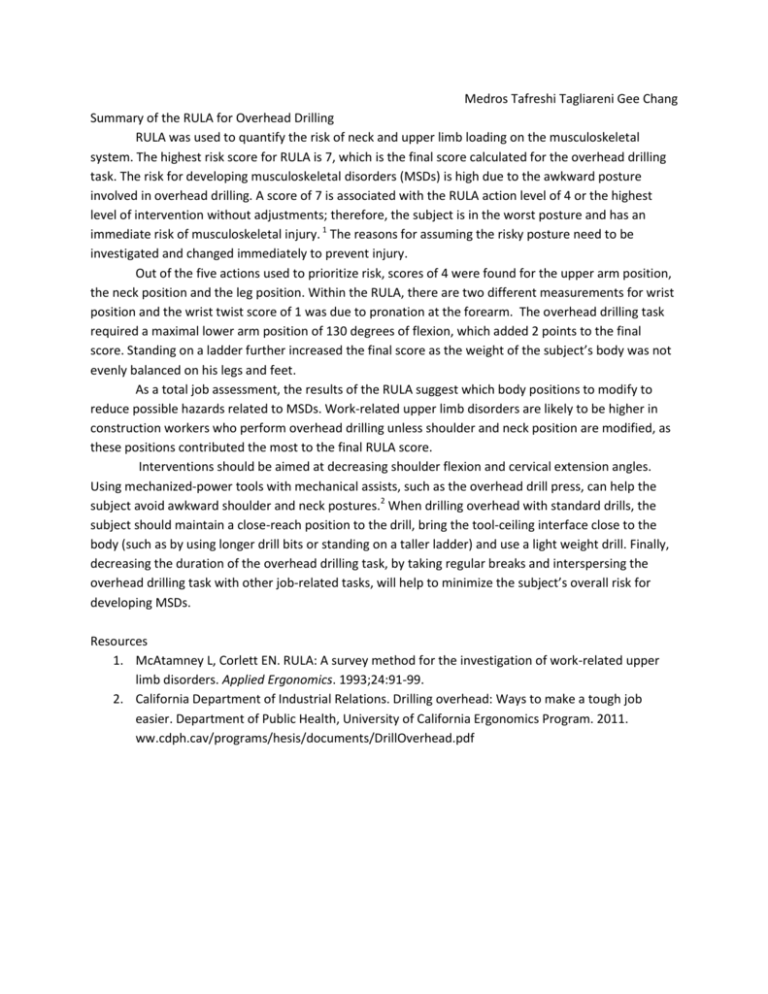
Medros Tafreshi Tagliareni Gee Chang Summary of the RULA for Overhead Drilling RULA was used to quantify the risk of neck and upper limb loading on the musculoskeletal system. The highest risk score for RULA is 7, which is the final score calculated for the overhead drilling task. The risk for developing musculoskeletal disorders (MSDs) is high due to the awkward posture involved in overhead drilling. A score of 7 is associated with the RULA action level of 4 or the highest level of intervention without adjustments; therefore, the subject is in the worst posture and has an immediate risk of musculoskeletal injury. 1 The reasons for assuming the risky posture need to be investigated and changed immediately to prevent injury. Out of the five actions used to prioritize risk, scores of 4 were found for the upper arm position, the neck position and the leg position. Within the RULA, there are two different measurements for wrist position and the wrist twist score of 1 was due to pronation at the forearm. The overhead drilling task required a maximal lower arm position of 130 degrees of flexion, which added 2 points to the final score. Standing on a ladder further increased the final score as the weight of the subject’s body was not evenly balanced on his legs and feet. As a total job assessment, the results of the RULA suggest which body positions to modify to reduce possible hazards related to MSDs. Work-related upper limb disorders are likely to be higher in construction workers who perform overhead drilling unless shoulder and neck position are modified, as these positions contributed the most to the final RULA score. Interventions should be aimed at decreasing shoulder flexion and cervical extension angles. Using mechanized-power tools with mechanical assists, such as the overhead drill press, can help the subject avoid awkward shoulder and neck postures.2 When drilling overhead with standard drills, the subject should maintain a close-reach position to the drill, bring the tool-ceiling interface close to the body (such as by using longer drill bits or standing on a taller ladder) and use a light weight drill. Finally, decreasing the duration of the overhead drilling task, by taking regular breaks and interspersing the overhead drilling task with other job-related tasks, will help to minimize the subject’s overall risk for developing MSDs. Resources 1. McAtamney L, Corlett EN. RULA: A survey method for the investigation of work-related upper limb disorders. Applied Ergonomics. 1993;24:91-99. 2. California Department of Industrial Relations. Drilling overhead: Ways to make a tough job easier. Department of Public Health, University of California Ergonomics Program. 2011. ww.cdph.cav/programs/hesis/documents/DrillOverhead.pdf Summary of Rhoemert’s Curve for Trigger Finger Rhoemert’s curve is a quantitative risk assessment tool evaluating static work that considers recovery time and contraction time relative to %MVC (maximum voluntary contraction). The key point demonstrated by Rhoemert’s curve is that the relationship between contraction time and recovery time is not linear but rather exponential. When the subject contracts for a longer amount of time he needs to take a longer rest period. After determining %MVC, there are two methods to use Rhoemert’s curve. One can either use a set recovery time to determine the permitted contraction time, or use a set contraction time to determine the necessary recovery time. A dynamometer was used to measure the values needed to determine the subject’s %MVC. First the subject’s trigger finger exertion was measured while having him simulate the force necessary to keep the drill activated during drilling and reaming (68.64N). Then the subject’s maximum exertion through the trigger finger was assessed (169.03N). The first value was divided into the latter to determine the %MVC of 40.61%. This prompted the use of the 40% curve. Contraction time was plotted based on the standard amount of holes drilled, which ranged between one to five holes. Both one and five holes fell within the initial, more linear, section of the curve. Recovery time helped determine the safest number of holes drilled based on contraction time. Close observation and analysis of the video showed there was approximately 20 seconds between when the subject relaxed the trigger finger and when he contracted it again. It took roughly 20 seconds for the subject to descend the ladder, move the ladder, and climb up the ladder again. Plotting 20 seconds of rest on the curve yielded 4 holes as the threshold for safety. The number of holes to drill without adding any additional rest time was determined. With 1 minute of rest between drilling, the subject could safely drill 6 holes. Circumstances may dictate the need to drill more holes at once. In this case, the subject would need to take 2 minutes of rest in order to safely drill 9 holes. As health care practitioners, this information would be provided to construction workers as an educational intervention aimed at preventing the onset and/or decreasing the magnitude of musculoskeletal injuries. Summary of the Moore-Garg Strain Index for Trigger Finger and The Hand The Moore-Garg Strain Index quantifies the level of risk for tasks which involve the distal upper extremities.1 The risk factors that are accounted for in the Moore-Garg Strain Index include the force, repetition, duration, and the work/rest cycle duration.2 Calculations of Stain Index (SI) for the trigger finger were performed for drilling overhead into two different material densities, including a dense and a porous material. Calculations of SI for the hand where performed for drilling into porous material only. The discrepancy between the two materials was primarily driven by the risk factor of intensity of exertion according to the BORG scale. The task of drilling into a porous material was a 3 on the BORG scale, versus drilling into a dense material was a 5 on the BORG scale. The second risk factor driving the difference between the Strain Indices was duration of exertion, which is a proportion of the exertion cycle. Drilling the same number of holes into a dense material would take more time (from resistance and friction of the material), consequently increasing the duration of exertion. The SI distinguishes between jobs that are associated with musculoskeletal disorders (MSD’s).1 The SI for dense material was calculated to be 13.5 and the SI for porous material was 4.5. Drilling into porous material is associated with an uncertain amount of risk for distal upper extremity injury. Since an SI of 7 is considered hazardous, drilling into dense material is associated with more risk of injury to the distal upper extremities. Even though the Moore-Garg Strain Index has greater sensitivity to intensity of exertion, the worker cannot control for the density of the material he/she has to drill into; therefore, this risk factor cannot be easily modified. The SI can be modified by changing the duration of exertion, which is a percentage of the cycle. As filmed, the subject took 2 seconds to align the drill, and drilled 1 hole into a porous material, which took approximately 4 seconds. The Moore-Garg SI was calculated considering the subject would drill 5 holes before re-positioning the ladder. The entire overhead drilling cycle for 5 holes would take 37.65 seconds. The subject would require more time if he was to drill into a denser material. In order to decrease the subject’s risk of injury for drilling into a dense material from hazardous to uncertain, the duration of exertion should be decreased to 29%. This would be impractical, assuming no change in cycle time, because this would allot less than 11 seconds to drill 5 holes into a porous material. A more practical solution to decrease the risk of injury from hazardous to some risk is to allow a duration of exertion of 49%, given there is no change in the cycle time. This would allow the subject to drill into a dense material for 18 seconds which would hypothetically allow the subject to drill 3 holes. The most practical solution that would most effectively decrease the risk of distal upper extremity injury would be to use a drill that has an option to lock the trigger. The worker therefore does not need to maintain the contraction throughout the entire cycle. This intervention, however, requires the worker to purchase a drill that has this feature. A second Moore-Garg Strain Index was calculated for the hand holding the drill. The subject picked up the drill prior to climbing the ladder and held the drill in hand when he descended the ladder. Because the subject has a sustained isometric contraction of the hand for the entire cycle, the risk factor that drove the SI so high was the duration of exertion. The value obtained was 6.75. Although this value is only in the “some risk” category, it is borderline in the “hazardous” category (>7). Also, because the hand is a crucial component to a construction worker’s job, it is important to limit any stress placed on them in order to prevent injury and decrease time off from work. The best intervention for this would be to encourage the subject to place the drill on the ladder before he ascended the ladder and to put it down before he returns to the ground. In other words, the worker should focus on holding the drill only for the necessary amount of time. According to the Moore-Garg Strain Index values, the subject should rest for 20% of the cycle. References 1. Moore JS, Garg A. The strain index: A proposed method to analyze jobs for risk of distal upper extremity disorders. Am Ind Hyg Assoc . 1995;56:443-458. 2. Harris C. Physical Risk Factors For Musculoskeletal Disorders. [Power Point]. Oakland, CA: SMU Physical Therapy Program; 2014.
